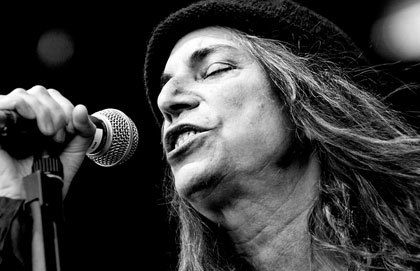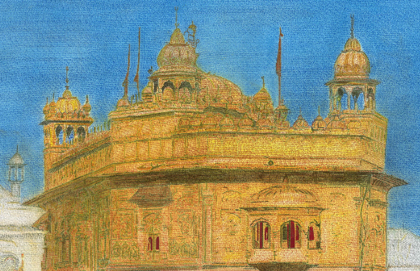In his introduction to Patti’s Smith’s gloriously strange and vivid 2018 book The New Jerusalem, Dutch writer Rob Riemen asks the essential question about one of the world’s great and famously invisible artists.
“In our own times, how many people besides Patti Smith can still see the relationship between Christ and art?” Riemen writes.
He acknowledges being startled during a conversation with Smith when she identified “Christ, of course,” as a member of the “religious family of artists” that includes Blake, Shelley, Oscar Wilde and Albert Camus and an infinitude of others.
“Christ? An artist?” a startled Riemen responded.
“Definitely,” Smith answered. “Oscar Wilde was absolutely right to point out in (De Profundis) that Christ, like an artist, is a completely free person. His ideal of salvation for mankind is sustained by imagination and can’t be achieved without imagination. Christ revealed, made us see what we couldn’t see, just as artists give expression to the invisible and unsayable. Yes, Christ certainly belongs to the family of artists.”
And when Riemen jokingly observed, “a holy family,” Smith said: “No, not holy. But I’m afraid many people don’t realize that we artists are a religious family.”
The exchange occurred after Riemen cold-called Smith to ask her to be part of his Nexus Institute symposium about “the New York counterculture as a university of life.” He was delighted when she accepted, and obviously trepidatious when he met her for the first time in the Gotham coffee shop where she writes. Reading between the lines, it’s equally evident he might have come with great expectations of encountering the Miss Havisham of the mid-1970s, if not wearing the perpetual wedding dress of Charles Dickens’ jilted spinster, then trapped in punk-era skin befitting a lover of Robert Mapplethorpe and the backroom darling of Andy Warhol’s menageries.
Smith herself has confirmed her debt of genesis to those figures, and to that mad floating countercultural carnival, in two sumptuous memoirs Just Kids and M Train. But to read the lucid prose of those books is to be galvanized by an unavoidable recognition. She was always, in her deep bones, through her powers of observation, perception and perhaps above all spiritual intuition, an artist of infinitely greater power than the period rubrics that tend to confine her reputation.
Godmother of punk? Yes. Okay. For a season or two, as it pleased her. It helped her achieve Rock and Roll Hall of Fame-level fame, kind of like, you know, Neil Young. Or Def Leppard.
But Smith, as her indefatigable band of devotees never tire of reminding a myopic world, was a poet first, and the punk flowed out of the poetry, and the punk qua punk passed, but the poetry, the Christ-artist imagination that feeds her visual art and her prose work as well, grew and flowered, and flourishes yet, though she turns 72 in December.
She still tours emphatically. A great friend of mine saw her perform in Dublin last June and was effectively speechless in trying to describe the sheer power and energy and artistic expression of the invisible and unsayable. In fact, on the day of the concert, my friend was touring nearby Kilmainham Gaol – where the savages of the British Army ordered the murder by firing squad of 15 brave and blessed Irish rebels following the glorious Easter, 1916 Rising – and she could hear Smith’s pre-show sound check through the old stone walls. She says her spine still hasn’t stopped shivering.
In addition to the music and the touring, Smith published The New Jerusalem earlier this year, and added new material for her breathtaking Devotion, originally brought out by Yale University Press in 2017 and re-released last month in paperback.
Both books are visionary quests that transform, into a question, Smith’s seemingly brash (though now recognizably humble?) contention to start the 1975 song Gloria (In Excelsis Deo), “Jesus died for somebody’s sins/but not mine.” As I argued in a review of Devotion last year, the question she seems to chase is this: “If not your sins, Patti Smith, then whose?” September’s re-issue of Devotion includes the fresh section Written On a Train, and it reveals in reproduction of her hand-written manuscript how meticulously she attends to that pursuit.
Closing the original version of Devotion, which was produced as part of Yale University Press’ Why I Write series, Smith wrote: “Why do I write? My finger, as a stylus, traces the question in the blank air. A familiar riddle posed since youth, withdrawing from play, comrades and the valley of love girded with work, a beat outside. Why do we write? A chorus erupts. Because we cannot simply live.”
The new manuscript material shows the “tracing” of the question to be done by a pen diligently crossing out, adding in, reconfiguring and renewing work of the hand in transit across the page. Added to the air-borne question of why we write is the earth-tethered exposition of how one writes, not just as abstraction but as physical manifestation, incarnate act. It fleshes out, too, Smith’s own punctilious appreciation of the beauty of a manuscript of Camus’ that she is allowed to view and hold during a visit to his former house and office. As she describes it in Devotion:
“For the next hour, I was privileged to examine the entire manuscript page by page. It was in his hand, each page suggesting a sense of unflinching unity with his subject. One could not help but thank the gods for apportioning Camus with a righteous and judicious pen….Several pages were augmented with his confident marking, lines carefully revised and sections firmly crossed. One could feel a sense of focused mission and the racing heart propelling the last words of the final paragraph, the last he was to write.”
With the inclusion of her own confident markings and firm crossings, Smith quietly affirms her place in the religious family of artists, augmented by an imagined vision of the ornate door that leads to Camus’ writing place, and of his then young daughter, Catherine, waiting for her papa to finish his work.
“(She) crouches beneath the (door’s) foreboding herald, which seems to emit a soft reddish glow. She imagines she can hear the scratching of her father’s pen. She waits furtively until it ceases to scratch, for then he will open the door, take her hand, descend the stairs and make her chocolate.”
More than domestic sentimentality, this is the union of art and familial love, of imagination and devotion in its purest sense. It is, in imitation of Christ, freedom sustained by imagination that cannot be achieved without imagination. Its antithesis is the spirit of the world that Smith assaults – there is no other word for it – with excruciating venom in the apocalyptic prose poems of The New Jerusalem, which are nothing if not a prophet’s cry against the modern mania for “God usurped by Goal. Chemical commerce the prime directive….enforced neo-naturalization, devoid of charity or human quality. Mercenary priests devis(ing) the moral centre. Iron and steel (rising) from the face of the holy city….” (“Matter of Time”).
The decrepitude deepens in “Triumph and Deceit” where the ritual slaughter of oxen overseen by a pampered and self-absorbed “princess, but no queen” ends in the prophetic calling forth that, “The jubilant are deaf and blind. The desecrated eye, bound in magnetic thread, is placed in a deep casket. The death note sounds, the numerical code sealed. This is their terrible covenant, known by none, languishing like the dream of a Pharaoh yearning to be deciphered.”
This is thanatocracy – the empire of death – gone to gore and madness. And yet there persists “The Alchemical Sovereign,” set on the facing page to a reproduction of da Vinci’s Salvator Mundi, wherein “salvation scavengers” recover from the “dust of labyrinthine cities” and the excavation of “monstrous vaults” an image that, passed from hand to hand, humbles all who gaze on it.
“His right hand raised in benediction, the left hand holding the orb of the world, encompassing the moment of creation. Staring into the sphere of crystal, we see ourselves, as if held in the palm of his hand. The eyes of the Sovereign are not raised above the heads of ravenous sheep. They level with our own, fixed where we cannot know, but will inhabit through him.”
And so to “The Cup” where, in a dream, the poem speaker/prophet is given an exquisite goblet of porcelain and, amid “carnage and famine and the bleached arms of power,” she raises “the empty cup to my lips, the rim stained with red tincture drawn from an ancient wound.”
Beyond the union of art and familial love found in Devotion, we have been moved to the marriage of Christ and art that is, to borrow a phrase from the unlikely source of Philip Larkin, a form of religious wounding. Or healing.
“I wrapped my writing tools in a piece of chamois and returned to the strange corridor where the heart ceases to beat but does not die,” we read in the final prose poem “A Time of Gifts.” “Refreshed, it increases just as the tribe may increase, a tribe of one. You are born, says a voice. It is the voice of the sixth day; it is the voice of inexhaustible good,” say the last words in The New Jerusalem.
The imagery, the imagination, is starkly Christian, which is not the same, obviously, as claiming Patti Smith holus bolus for the Christian tribe. Her insistence that Christ is an artist is no more prima facie substantiation of conversion to formal Christian faith than her approval of Oscar Wilde’s De Profundis is acceptance of his taste in wallpaper. (Wilde, the great aesthete, is famously quoted as having said on his death bed: “Either that wallpaper will have to go, or I will.”)
Yet any fair-minded person who follows Smith, shall we say, religiously can’t help but note her spiritual movement in a decidedly Christian direction. And that movement seems to have been initiated a long way back, from the deepest source of her being. It’s there even in her early break-out hit Because the Night, an ostensible anthem for unbridled passion, given to her as a gift by Bruce Springsteen because, after writing it, he realized it didn’t fit with his Darkness on the Edge of Town album. Consider this stanza, which bursts with the genuine shout of faith that so-called Christian rock can only self-gratifyingly feign:
Come on now try and understand
The way I feel under your command
Take my hand as the sun descends
They can't touch you now,
Can't touch you now, can't touch you now
Because the night belongs to lovers....
Better yet, listen to Smith sing it in her voice that can make spines shiver through the stone walls of Kilmainham Gaol, and sound like a cry to God. If that does not settle definitively the state of her official religious conviction, it certainly helps us with Rob Riemen’s question about who today can still see the relationship between Christ and art. The answer, uniquely hers even within the religious family of artists, is visibly Patti Smith.
Convivium means living together. We welcome your voice to the conversation. Do you know someone who would enjoy this article? Send it to them now. Do you have a response to something we've published? Let us know!





